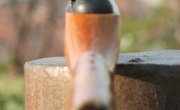Introduction
A magnifying glass isn't always used merely for magnification. The unique properties of a magnifying glass have long been known to have the ability to create a fire. In the absence of matches or a lighter, a magnifying glass is a great tool for any wilderness survivalist. There's science behind the magic of such a trick.
The Process
A magnifying glass starts a fire through the use of heat from the sun. This is done by positioning the glass so that the sun's rays pass through the lens, forming a small point of light on a pile of dry kindling. If the sun's light is hot enough, the kindling is dry enough and the focal strength of the lens is adequate, a fire will eventually spark.
Why it Works
The science behind lighting a fire with a magnifying glass can be found in the form of photos. Photons are the particles that carry visible light from the sun to the earth. They also contain energy in the form of heat. Through the use of a magnifying glass, the path of these photons are narrowed to a highly localized area (the dot of light that passes through the lens). This results in a concentration of heat that can reach incredibly high temperatures. If a high enough temperature is reached (somewhere around 450 degrees F), the kindling will smolder and begin to burn.
Additional Info
The key to localizing photons is in the convex shape of the magnifying lens. This shape collects photons on one side of the lens and draws them to a single point as they enter out the other side. As such, any item with a convex lens can be used to start a fire. For example, a pair of eyeglasses or a binocular lens can also be used. However, the larger the lens, the more easily it will be to start a fire. The steepness of the convex shape also plays a part in achieving the extreme heat needed to achieve combustion.
Writer Bio
Based in Los Angeles, Jeff Wysaski has been a professional writer since 2005. He has written for such varied online publications as AOL Travel, Autotropolis, RadioShack and Manolith. Wysaski earned a Bachelor of Arts in marketing from the University of North Texas in 2004.



